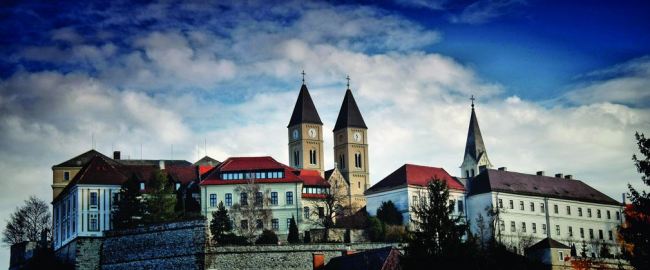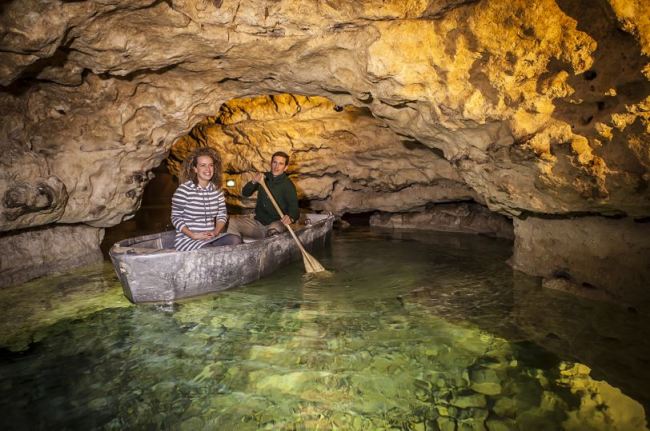Hidden treasures of Hungary
Travelers frequent cave bath town, vineyards, old cities, lake, abbey and more
By Korea HeraldPublished : Oct. 24, 2014 - 16:45
Aside from the bustling capital city of Budapest, Hungary is still little known to many Asian tourists who are frequent travelers to European cities.
With the aim to reveal the country’s hidden treasures, the Hungarian Embassy to Korea recently offered a group of Korean journalists a rare opportunity to look around several small cities there.
In reflection of the agency’s strong will to show more about the country, the weeklong schedule was packed with diverse but brief programs, but it was long enough to get a hint of the true virtues of traveling Hungary.
Our first destination was Miskolc, an industrial city in northeastern Hungary. Since its traditional mining industry started fast declining in the 1990s, the city government has ramped up efforts to develop tourist attractions.
A unique cave bath town, including the famous Barlangfurdo, is one of the most popular holiday destinations for Hungarians.
An hourlong drive from Miskolc is Tokaj, one of the oldest wine regions in Europe -― older than Bordeaux in France or Chianti in Italy. Most of some 10,000 residents work for 50 wineries there.
And the town is known for its legendary sweet wine, Tokaji Aszu. The word aszu means “wine” in Hungarian.
Many of the region’s vineyards are planted with furmint, a white grape variety especially conducive to fungus. When botrytis attacks, the grapes dry up. This concentrates the sugars, creating a characteristic sweet flavor.
It is a centuries-old way of winemaking that dates back to the era when the Ottoman Empire occupied Hungary.
The Turkish used to make raids across the border with Tokaj, during which the winemakers had to hide. Afterwards, they came back and made wine out of the grapes that had rotted while they were gone.
Due to its unusual blend of history and culture, the town earned the UNESCO World Heritage status in 2002.
Wineries in the region are now operated together with resort hotels and they open their cellars to visitors for wine-tasting.
Veszprem, a tourist city some 15 kilometers north of the Lake Balaton, is called the “City of Queens.”
With the aim to reveal the country’s hidden treasures, the Hungarian Embassy to Korea recently offered a group of Korean journalists a rare opportunity to look around several small cities there.
In reflection of the agency’s strong will to show more about the country, the weeklong schedule was packed with diverse but brief programs, but it was long enough to get a hint of the true virtues of traveling Hungary.
Our first destination was Miskolc, an industrial city in northeastern Hungary. Since its traditional mining industry started fast declining in the 1990s, the city government has ramped up efforts to develop tourist attractions.
A unique cave bath town, including the famous Barlangfurdo, is one of the most popular holiday destinations for Hungarians.
An hourlong drive from Miskolc is Tokaj, one of the oldest wine regions in Europe -― older than Bordeaux in France or Chianti in Italy. Most of some 10,000 residents work for 50 wineries there.
And the town is known for its legendary sweet wine, Tokaji Aszu. The word aszu means “wine” in Hungarian.
Many of the region’s vineyards are planted with furmint, a white grape variety especially conducive to fungus. When botrytis attacks, the grapes dry up. This concentrates the sugars, creating a characteristic sweet flavor.
It is a centuries-old way of winemaking that dates back to the era when the Ottoman Empire occupied Hungary.
The Turkish used to make raids across the border with Tokaj, during which the winemakers had to hide. Afterwards, they came back and made wine out of the grapes that had rotted while they were gone.
Due to its unusual blend of history and culture, the town earned the UNESCO World Heritage status in 2002.
Wineries in the region are now operated together with resort hotels and they open their cellars to visitors for wine-tasting.
Veszprem, a tourist city some 15 kilometers north of the Lake Balaton, is called the “City of Queens.”

Starting with Queen Gisela, the wife of Hungary’s first King Stephen, the queens of Hungary were crowned by the bishop of Vesprem. They also used to stay in the city during invasions.
Reflecting the historic background, the city boasts a serene and elegant ambience. While the old town maintains its historic beauty, well-organized residential and commercial areas offer more stylish and modern experience to visitors.
The city operates diverse walking-tour programs for tourists to fully enjoy its scenic beauty.
The Lake Balaton, the largest lake in Central Europe, is one of the most popular holiday spots for people living in the neighborhood.
The lake, acting as a mirror, affects the Mediterranean-like sunny weather in the neighboring areas. Especially the southern shore has been developed as a luxury resort town for wealthy people from centuries ago.

Zirc, a small town in the Veszprem county, is best known for the famous Zirc Abbey, a Cistercian abbey built in the 12th century.
The Cistercian Order stressed labor and self-sufficiency of monks and nuns, and many abbeys traditionally supported themselves through activities like agriculture and brewing ales.
Over the centuries, education and academic pursuits came to dominate the life of their monasteries.
Zirc Abbey was dissolved in 1950, and its church became a parish church. The monastery was reestablished in 1989 and maintains residences in some areas.
Herend, home to the renowned Hungarian porcelain manufacturing, is also a must-see for luxury shoppers.
Founded in 1826, Herend Porcelain is one of the world’s largest handmade porcelain factories. In the mid-19th century, it was purveyor to Hungarian royal families and aristocratic customers across Europe.
Many of its classic patterns are still in production. Its tableware is widely enjoyed by celebrities around the world.
At the factory, Herend artisans demonstrate the actual porcelain-making process for visitors. A Herend shop there also offers discount deals for porcelain products.
During the weeklong stay in Hungary, I found: Hungarian forint is still preferred over the euro in many cities; prices for noble hotels and restaurants are absurdly low; and the cities are a lot less crowded other European cities.
Among other things, Asian tourists are a rare sight in most of the cities. And it is good to be more visible in a foreign country because local people are always willing to help you.
By Lee Ji-yoon (jylee@heraldcorp.com)
-
Articles by Korea Herald










![[Hello India] Hyundai Motor vows to boost 'clean mobility' in India](http://res.heraldm.com/phpwas/restmb_idxmake.php?idx=644&simg=/content/image/2024/04/25/20240425050672_0.jpg&u=)








